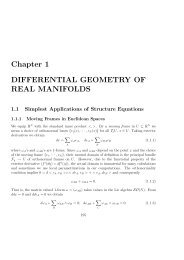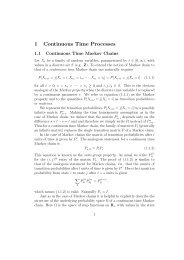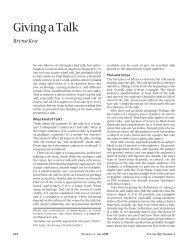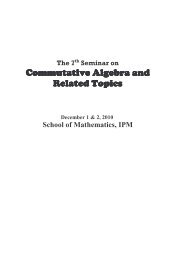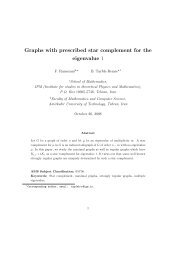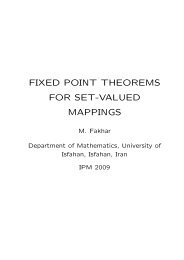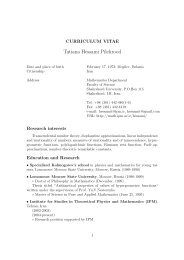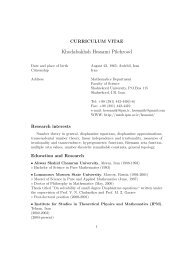Betti numbers of modules over Noetherian rings with ... - IPM
Betti numbers of modules over Noetherian rings with ... - IPM
Betti numbers of modules over Noetherian rings with ... - IPM
You also want an ePaper? Increase the reach of your titles
YUMPU automatically turns print PDFs into web optimized ePapers that Google loves.
Chapter 2: Linear resolution <strong>of</strong> powers <strong>of</strong> an ideal 25<br />
I, in any <strong>of</strong> these ways, emphasizes the structure <strong>of</strong> the polynomial relations amongst<br />
the elements <strong>of</strong> a generating set <strong>of</strong> I. Here we start <strong>with</strong> a matrix <strong>of</strong> presentation <strong>of</strong><br />
the ideal I = (f1, . . . , fm), and using elimination theory directly or via Gröbner basis<br />
computations, one seeks to describe P.<br />
As it was indicated in [67] studying the Rees algebra <strong>of</strong> an ideal I is focused on the<br />
degrees <strong>of</strong> a generating set for the presentation ideal P and seeks to obtain those<br />
equations from the syzygies <strong>of</strong> I. The ideal P, which we refer to as the equations <strong>of</strong><br />
R[It], is graded (in fact, a bigraded ideal <strong>of</strong> T ):<br />
P = P1 + P2 + · · · ,<br />
where P1 is the R-module <strong>of</strong> linear forms aiti such that aifi = 0. The module<br />
Pr is the module <strong>of</strong> syzygies <strong>of</strong> the r-products <strong>of</strong> the fi.<br />
Example 2.2.1. From [67, Example 1.2], if the ideal I is generated by a regular<br />
sequence f1, · · · , fm, the equations <strong>of</strong> R(I)are nice:<br />
⎛<br />
R(I) ∼ ⎜<br />
= S[t1, . . . , tm]/I2 ⎝ t1 · · · tm<br />
f1 · · · fm<br />
⎞<br />
⎟<br />
⎠ .<br />
In other words, P is generated by the Koszul relations <strong>of</strong> the fi.<br />
Now let R be a ring and M a finitely generated R-module. We discuss presenta-<br />
tions <strong>of</strong> the symmetric algebra <strong>of</strong> M. The symmetric algebra SR(M), or simply S(M),<br />
is the algebra<br />
SR(M) = TR(M)/(x ⊗ y − y ⊗ x, x, y ∈ M)<br />
where TR(M) is the tensor algebra <strong>of</strong> M <strong>over</strong> R. It is convenient to give it in terms<br />
<strong>of</strong> generators and relations. This arises directly from a free presentation <strong>of</strong> M, as



